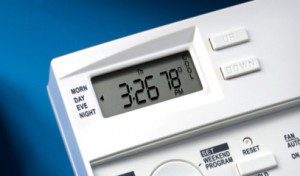 With the fluctuating weather these days, navigating the temperatures in your home may become a bit more tedious. At night it’s cool enough to bundle up, but do you want to turn your heat on? In the afternoon, it’s warm enough to lose some layers, but do you turn on the air? What if you leave your thermostat on the wrong temperature all day? Nobody wants to come home to that.
With the fluctuating weather these days, navigating the temperatures in your home may become a bit more tedious. At night it’s cool enough to bundle up, but do you want to turn your heat on? In the afternoon, it’s warm enough to lose some layers, but do you turn on the air? What if you leave your thermostat on the wrong temperature all day? Nobody wants to come home to that.
Misinformation often leads either to inaction or improper action. Many people believe that it takes more energy and costs more money to change the temperatures on their thermostats when they’re away from home or sleeping, thinking that a constant temperature keeps the unit from using too much energy.
However, the U.S. Department of Energy disagrees with this: The recommendation is to match outdoor temperatures as much as is comfortable for you. To set the temperature higher in the summer and lower in the winter, particularly when no one is in the home, is the best way to save energy and money. Take a look at this chart of recommended thermostat settings throughout the day for a normal home and family who are at work and school all day.
| Period | Time | Heat Set Point (In Winter) | Cool Set Point (In Summer) | Fan Setting |
| Wake | 6:00 AM | 70°F (21°C) | 78°F (25.5°C) | Auto |
| Leave | 8:00 AM | 62°F (16.5°C) | 85°F (29.5°C) | Auto |
| Return | 6:00 PM | 70°F (21°C) | 78°F (25.5°C) | Auto |
| Sleep | 10:00 PM | 62°F (16.5°C) | 82°F (28°C) | Auto |
Forgetting to do this can be the main problem – it has been for me. The answer?
Programmable Thermostats
Programmable thermostats make it easier to manage temperatures at certain times, which can save you up to 20% on your energy bills over the year. With these, you can “set it and forget it” and rest easy knowing that it will be a comfortable temperature when you need it to be without using unnecessary amounts of energy. Contrary to popular belief, the unit does not actually “work harder” to reach these temperatures. Therefore, it actually is more efficient to let the unit meet your temperatures when you need them met.
If you have the ability to program your current thermostat but have been on the fence about it, try it for a time and see how it goes. If you don’t have a programmable thermostat, it’s definitely worth looking into.
The U.S. Department of Energy has some great articles on the subject. Check them out at www.energy.gov and search for programmable thermostats. Once you’ve done some research and decided what’s best for your home and family, give us a call at Tropical Air or check out our website at acnotworking.com and gain powerful insight about decreasing your energy costs while you feel the breeze.
Keep Cool, Warm, and Informed,
Rikki Payne
Your Licensed A/C and Heating Connection
321-972-9935
www.Tropical-Air.com
www.ACNotWorking.com
Serving Greater Central Florida


